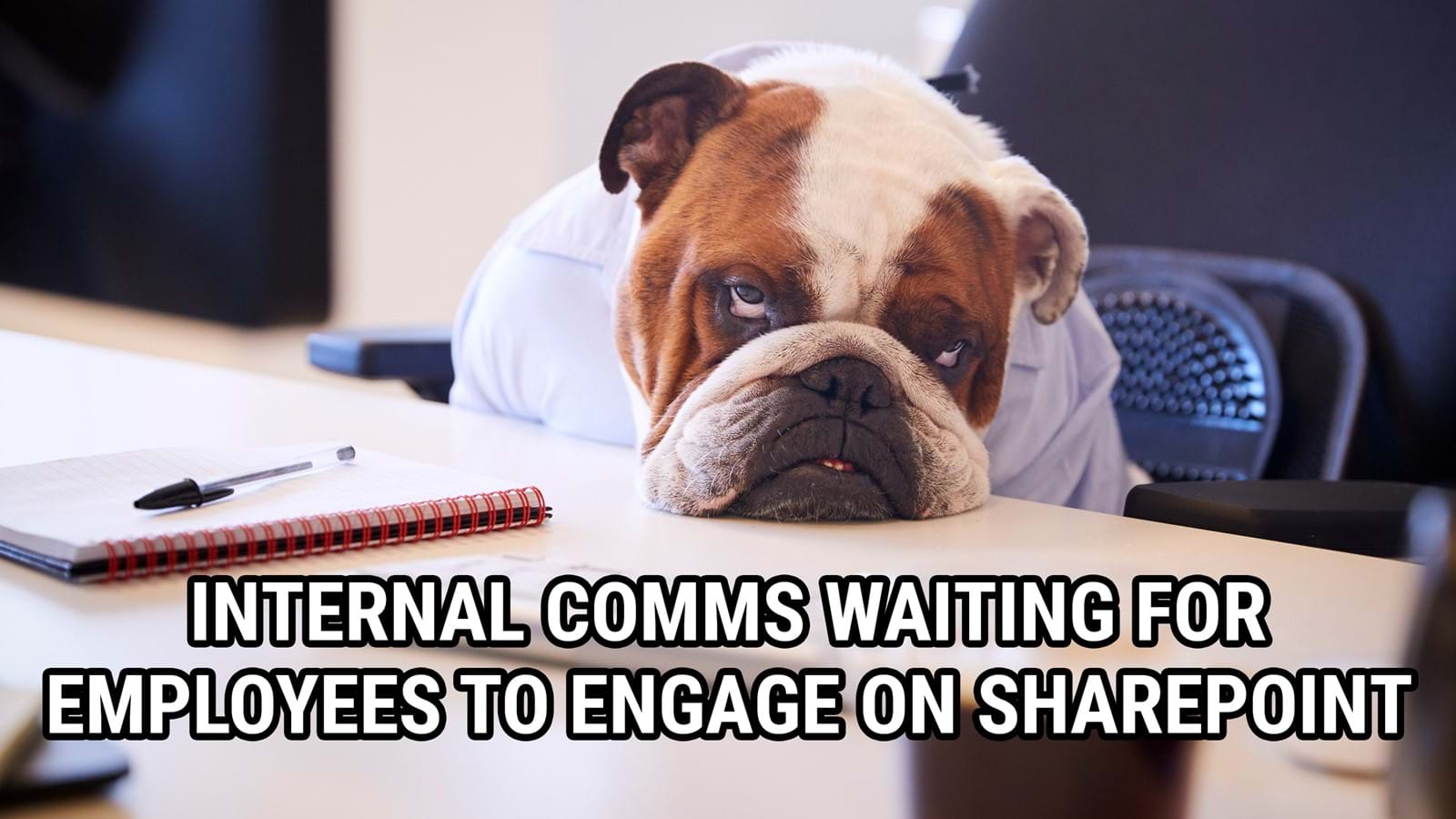
Why SharePoint doesn't work for enterprise communications
We hear it time and time again: internal comms recognize that to level up employee engagement they need to invest in an intranet upgrade. They go to their IT team with a list of compelling options and asks, and they leave with SharePoint. Why? Because they're a Microsoft-led organization! It integrates perfectly into their existing tech stack! It does everything they would ever need an intranet to do!
If that's the case, why is it common knowledge that internal communicators don't like SharePoint? And why do so many organizations that use SharePoint as their intranet end up moving on? And why when you Google 'SharePoint memes' do you find this?

The truth is that while SharePoint is great at many things, one thing it's not great at is driving engagement with enterprise communications. With the invention of Viva, even Microsoft acknowledge that SharePoint is not an employee engagement tool. It's a document management and storage system; it helps store knowledge effectively and in doing so promotes more productive team collaboration. It is not a comms platform and with all the will and shoe-horning in the world, it can't compete with a modern employee experience platform.
SharePoint is the platform chosen by IT for internal communications, but given the choice few internal comms teams would choose SharePoint for themselves. Even back in 2013, a Forrester survey of business leaders using SharePoint found that:
- Businesses don't see the degree of adoption expected (64%)
- Users find it difficult to use (62%)
- Users prefer other tools (49%)
- Businesses don't see any added benefit (44%)
- SharePoint does not reach functional requirements (44%)
SharePoint Intranet
Maximize your SharePoint investment with an employee experience platform (EXP) built to engage employees, transform internal communications, and unite your applications.
Learn moreSo why do so many organizations get stuck with a SharePoint intranet?
If SharePoint was never designed to be a comms platform or employee engagement tool, why is it that so many enterprises end up with a SharePoint intranet? The answer lies in the history of intranets.
Throughout the 2000s Microsoft 365 and SharePoint became something of an industry-standard in productivity and collaboration tools. If you wanted an enterprise intranet, there weren't many places to turn so SharePoint filled an emerging gap. But that was twenty years ago. Today the market is a different beast. According to Forrester:
Unily named a leader in the 2024 Forrester Wave™ for Intranet Platforms“The intranet market has undergone a major reinvention over the last few years. New, cloud-native platforms have shattered the stereotype of static, clunky, internal portals. Today intranets are software as a service (SaaS) apps and are designed for the communicators, designers, and authors who are responsible for creating relevant, tailored information for employees in an anywhere-work environment.”
The Forrester Wave™: Intranet Platforms Report, 2022
Evolved expectations, evolved market
There’s no denying that SharePoint has had a monumental impact on the enterprise tech stack. For many years, it was the definitive collaboration solution, but now the market hasn’t just caught up – it’s overtaken it.
Modern workplaces and modern employees demand more from their intranet than SharePoint can offer. Today an intranet isn't just an information warehouse, it's a central hub that every employee can connect with to enhance the employee experience and engage with company dialogue. It's a personalized home for communications, knowledge and systems. It's the heart of the digital workplace and the bedrock of internal communications.
And the platforms that power modern intranets and employee experience platforms? They're Out-of-the-Box solutions that have developed over the course of the last twenty years to meet specific employee experience use-cases. Many of them started as SharePoint bolt-ons, fillings the gaps that SharePoint couldn't without heavy customization. But today these platforms are stand-alone, built for purpose solutions that operate independently from SharePoint.
This new breed of employee experience platforms come packed with features from intuitive CMS' with things like content review cycles, drag and drop templates, campaign building and automation features, all designed specifically to meet the needs of enterprise internal communicators. They also include other features like native reward and recognition, social channels, ideation and a wide range of integration options designed to unite complex digital landscapes and power more seamless ways of working.
Beyond SharePoint: How to supercharge adoption with a true EX Platform
Find out why large enterprises are making the switch from SharePoint and unpack the benefits of a true EX Platform for transforming Organizational Velocity.
Watch nowAnd that's why, today, internal communicators know that relying on SharePoint means an uphill battle to engage employees and transform internal communications for the hybrid future. It’s like asking Tiger Woods to tee off with a putter. Sure, it’ll work – the ball will move – but you’re not going to get the same results as you would with a tool designed specifically for that job.
5 top reasons why SharePoint doesn’t cut it for internal comms
Communicators stuck with SharePoint look to greener pastures and see platforms offering useful features and engaging experiences – solutions designed specifically for their needs that bring the best of SharePoint mixed with advances in enterprise technology, from AI to integrations. It’s no surprise then, that internal communications want more than SharePoint can offer. So what are the top reasons that SharePoint can't and won't work as a modern intranet or communications platform?
1. SharePoint lacks essential comms functionality
Coming in first is a lack of comms functionality. Today's employees, especially the new generation of digital natives, have high expectations when it comes to what engaging content looks like. To reach them - and more importantly, to engage them - means meeting those expectations. Trying to do this with SharePoint is nearly impossible. For an intranet to work as an engagement tool it needs to deliver experiences that match up to those we get in our personal lives. Comms need to be personalized, available on any device, and delivered through an array of channels in a range of formats. SharePoint simply doesn't offer the functionality to deliver on these expectations.

2. SharePoint can't unite comms channels
Building on the point above, one of the key areas SharePoint falls short as an intranet but particularly in the comms scenario is its inability to integrate beyond the Microsoft stack. Enterprises rely on hundreds if not thousands of third-party tools and systems, and, without a lot of customization, SharePoint won't integrate with these tools. But more importantly for communicators, SharePoint can't integrate with non-Microsoft comms channels like Slack. As communicators become more focused on meeting employees where they are with comms - i.e. on the channels they're using day-to-day - SharePoint presents a major blocker to uniting comms channels and bringing omnichannel experiences to life.
3. SharePoint means relying on IT
One of the biggest reasons internal comms struggle with SharePoint is that it means relying on IT resources to implement even the smallest of changes. In the fast-paced, unpredictable business landscape we're operating in, the ability to rapidly react to change is crucial to meeting employees' changing needs. Because SharePoint requires technical know-how to develop, internal comms are unable to take ownership of one of their most important tools and must turn to IT to evolve the platform to meet new demands. Since IT teams have a breadth of systems and responsibilities to manage, internal comms often find themselves at the end of a long queue causing intranet development to stagnate. In contrast, modern employee experience platforms are designed for internal communicators to own and be able to adapt with little technical knowledge.
The Estée Lauder Companies: Designing the world's best intranet
Discover how The Estée Lauder Companies is transforming employee experience and internal communications for 60k+ global employees with Unily's employee experience platform. Get an exclusive look inside the world's best intranet of 2022 and learn why MyELC made history as the first-ever beauty company intranet to feature in the Nielsen Norman Group's Intranet Design Annual.
Read the case study4. SharePoint lacks critical measurement and analytics capabilities
Being able to measure the efficacy of internal communications campaigns is a critical part of evolving employee engagement strategies. Since SharePoint wasn't built to be an internal comms platform, it doesn't offer the kind of analytics internal communicators need to measure engagement with comms. Without a view of what employees are engaging with, when and how, internal comms strategies become guesswork and ROI is impossible to prove.
5. SharePoint fails for frontline workers
Finally, one of SharePoint's most high-profile pain points is its mobile experience... or lack of. For enterprises with frontline workforces who rely on mobile to access company information, SharePoint simply doesn't work. Not only is the mobile experience lacking functionality and aesthetic appeal, but it also comes at a high cost. Access to SharePoint requires a Microsoft license, something deskless workers don't usually have. For those employees to gain access to SharePoint, that means investing in costly Microsoft licenses for everyone or leaving a vast swathe of the employee population out of the loop.
Get the right tool for the job, drive engagement with an Employee Experience Platform
Internal communicators need more than what SharePoint can offer to engage and align employees. Discover what an employee experience platform can do that SharePoint can't.
Get started. Get your personalized demo.
Discover how Unily could transform organizational velocity at your organization.

Charlie has spent 8 years helping large enterprises to improve both customer and employee experiences. As Product Marketing Manager at Unily, Charlie plays an instrumental role in keeping Unily's capabilities and product vision aligned to the needs and aspirations of employee experience leaders. Charlie covers Unily's Frameworks & Extensibility, and EX Insights product pillars and is a critical contributor to thought leadership content and a regular speaker at industry events.